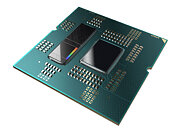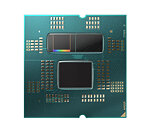- Joined
- Oct 9, 2007
- Messages
- 47,241 (7.55/day)
- Location
- Hyderabad, India
| System Name | RBMK-1000 |
|---|---|
| Processor | AMD Ryzen 7 5700G |
| Motherboard | ASUS ROG Strix B450-E Gaming |
| Cooling | DeepCool Gammax L240 V2 |
| Memory | 2x 8GB G.Skill Sniper X |
| Video Card(s) | Palit GeForce RTX 2080 SUPER GameRock |
| Storage | Western Digital Black NVMe 512GB |
| Display(s) | BenQ 1440p 60 Hz 27-inch |
| Case | Corsair Carbide 100R |
| Audio Device(s) | ASUS SupremeFX S1220A |
| Power Supply | Cooler Master MWE Gold 650W |
| Mouse | ASUS ROG Strix Impact |
| Keyboard | Gamdias Hermes E2 |
| Software | Windows 11 Pro |
AMD today announced its new Ryzen 7000X3D high-end desktop processors to much fanfare, with availability slated for February 2023, you can read all about them in our older article. In our coverage, we noticed something odd about the cache sizes of the 12-core 7900X3D and 16-core 7950X3D. Whereas the 8-core, single-CCD 7800X3D comes with 104 MB of total cache (L2+L3), which works out to 1 MB L2 cache per core and 96 MB of L3 cache (32 MB on-die + 64 MB stacked 3DV cache); the dual-CCD 7900X3D and 7950X3D was shown with total caches of 140 MB and 144 MB, while they should have been 204 MB or 208 MB, respectively.
In our older article, we explored two possibilities—one that the 3DV cache is available on both CCDs but halved in size for whatever reason; and the second more outlandish possibility that only one of the two CCDs has stacked 3DV cache, while the other is a normal planar CCD with just the on-die 32 MB L3 cache. As it turns out, the latter theory is right! AMD put out high-resolution renders of the dual-CCD 7000X3D processors, where only one of the two CCDs is shown having the L3D (L3 cache die) stacked on top. Even real-world pictures of the older "Zen 3" 3DV cache CCDs from the 5800X3D or EPYC "Milan-X" processors show CCDs with 3DV caches having a distinct appearance with dividing lines between the L3D and the structural substrates over the regions of the CCD that have the CPU cores. In these renders, we see these lines drawn on only one of the two CCDs.




It shouldn't be hard for such an asymmetric cache setup to work in the real world from a software perspective, given that we are now firmly in the era of hybrid-core processors thanks to Intel and Arm. Even way before "Alder Lake," when AMD started shipping dual-CCD client processors with the Ryzen 3000 "Matisse" based on "Zen 2," the company closely collaborated with Microsoft to optimize OS scheduling such that high-performance and less-parallelized workloads such as games, are localized to just one of the two CCDs, to minimize DDR4 memory roundtrips.
Even before "Matisse," AMD and Microsoft confronted multi-threaded workload optimization challenges with dual-CCX architectures such as "Zen" and "Zen 2," where the OS scheduler would ideally want to localize gaming workload to a single CCX before saturating both CCXs on a single CCD, and then onward to the next CCD. This is achieved using methods such as CPPC2 preferred-core flagging, and which is why AMD highly recommends you to use their "Ryzen Balanced" Windows power-plan included with their Chipset drivers.
We predict that something similar is happening with the 12-core and 16-core 7000X3D processors—where gaming workloads can benefit from being localized to the 3DV cache-enabled CCD, and any spillover workloads (such as audio stack, network stack, background services, etc) are handled by the second CCD. In non-gaming workloads that scale across all 16 cores, the processor works like any other multi-core chip, it's just that the cores in the 3DV-enabled CCD have better performance from the larger victim cache. There shouldn't be any runtime errors arising from ISA mismatch, as the CPU core types on both CCDs are the same "Zen 4."
AMD Ryzen 7000X3D processors go on sale in February 2023.
View at TechPowerUp Main Site
In our older article, we explored two possibilities—one that the 3DV cache is available on both CCDs but halved in size for whatever reason; and the second more outlandish possibility that only one of the two CCDs has stacked 3DV cache, while the other is a normal planar CCD with just the on-die 32 MB L3 cache. As it turns out, the latter theory is right! AMD put out high-resolution renders of the dual-CCD 7000X3D processors, where only one of the two CCDs is shown having the L3D (L3 cache die) stacked on top. Even real-world pictures of the older "Zen 3" 3DV cache CCDs from the 5800X3D or EPYC "Milan-X" processors show CCDs with 3DV caches having a distinct appearance with dividing lines between the L3D and the structural substrates over the regions of the CCD that have the CPU cores. In these renders, we see these lines drawn on only one of the two CCDs.




It shouldn't be hard for such an asymmetric cache setup to work in the real world from a software perspective, given that we are now firmly in the era of hybrid-core processors thanks to Intel and Arm. Even way before "Alder Lake," when AMD started shipping dual-CCD client processors with the Ryzen 3000 "Matisse" based on "Zen 2," the company closely collaborated with Microsoft to optimize OS scheduling such that high-performance and less-parallelized workloads such as games, are localized to just one of the two CCDs, to minimize DDR4 memory roundtrips.
Even before "Matisse," AMD and Microsoft confronted multi-threaded workload optimization challenges with dual-CCX architectures such as "Zen" and "Zen 2," where the OS scheduler would ideally want to localize gaming workload to a single CCX before saturating both CCXs on a single CCD, and then onward to the next CCD. This is achieved using methods such as CPPC2 preferred-core flagging, and which is why AMD highly recommends you to use their "Ryzen Balanced" Windows power-plan included with their Chipset drivers.
We predict that something similar is happening with the 12-core and 16-core 7000X3D processors—where gaming workloads can benefit from being localized to the 3DV cache-enabled CCD, and any spillover workloads (such as audio stack, network stack, background services, etc) are handled by the second CCD. In non-gaming workloads that scale across all 16 cores, the processor works like any other multi-core chip, it's just that the cores in the 3DV-enabled CCD have better performance from the larger victim cache. There shouldn't be any runtime errors arising from ISA mismatch, as the CPU core types on both CCDs are the same "Zen 4."
AMD Ryzen 7000X3D processors go on sale in February 2023.
View at TechPowerUp Main Site






